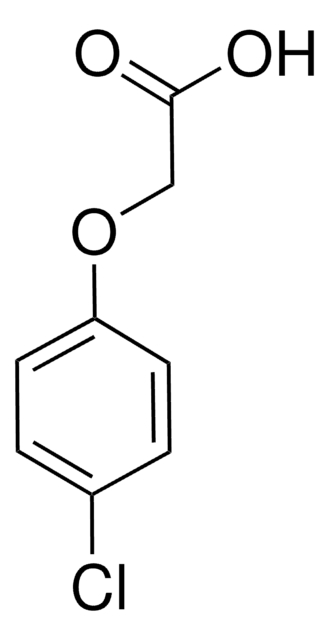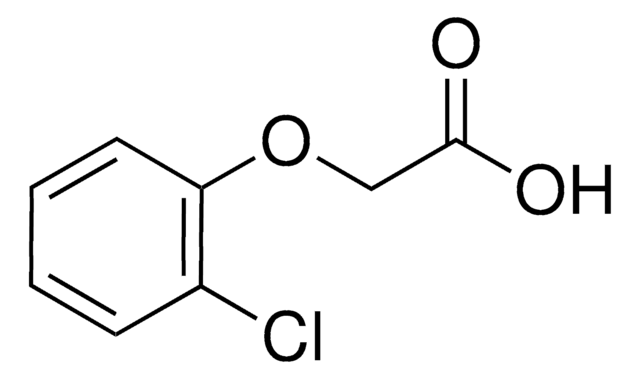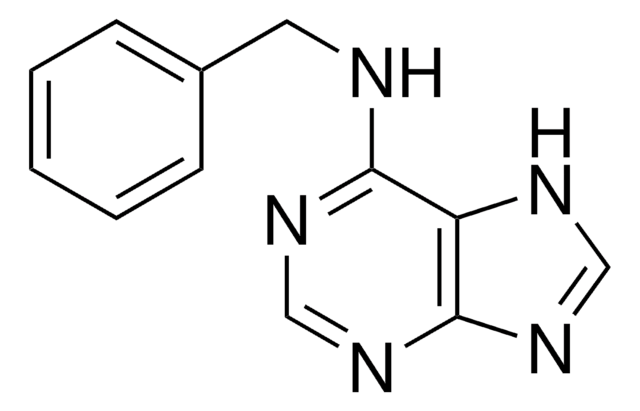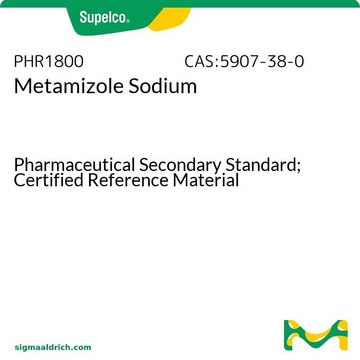25890
4-Chlorophenoxyacetic acid
≥98.0% (T)
Synonym(s):
4-CPA
Sign Into View Organizational & Contract Pricing
All Photos(3)
About This Item
Empirical Formula (Hill Notation):
C8H7ClO3
CAS Number:
Molecular Weight:
186.59
Beilstein:
1211804
EC Number:
MDL number:
UNSPSC Code:
12352100
PubChem Substance ID:
NACRES:
NA.22
Recommended Products
Assay
≥98.0% (T)
form
powder
functional group
carboxylic acid
chloro
SMILES string
OC(=O)COc1ccc(Cl)cc1
InChI
1S/C8H7ClO3/c9-6-1-3-7(4-2-6)12-5-8(10)11/h1-4H,5H2,(H,10,11)
InChI key
SODPIMGUZLOIPE-UHFFFAOYSA-N
Looking for similar products? Visit Product Comparison Guide
General description
4-Chlorophenoxyacetic acid is a herbicide. Degradation of 4-chlorophenoxyacetic acid in aqueous medium by advanced electrochemical oxidation processes, using an undivided cell containing a Pt anode has been reported.
Application
- Innovative adsorbents for chemical analysis: The application of three-dimensional material CZIF-8/CS-MS was explored as adsorbents for the determination of plant growth regulators including 4-Chlorophenoxyacetic acid in traditional Chinese medicine, improving the precision and efficiency of chemical residue analysis (Zhang et al., 2024).
Signal Word
Warning
Hazard Statements
Precautionary Statements
Hazard Classifications
Acute Tox. 4 Oral
Storage Class Code
11 - Combustible Solids
WGK
WGK 1
Flash Point(F)
Not applicable
Flash Point(C)
Not applicable
Personal Protective Equipment
dust mask type N95 (US), Eyeshields, Gloves
Choose from one of the most recent versions:
Already Own This Product?
Find documentation for the products that you have recently purchased in the Document Library.
Song Zhu et al.
Food science and biotechnology, 29(11), 1587-1595 (2020-10-23)
Determination of phytohormones have attracted increasing attentions in food safety field. In this study, an efficient and quantitative method was developed which can simultaneously determinate thirteen phytohormones in fruits and vegetables using solid phase extraction (SPE) combined with high performance
Sze Chieh Tan et al.
Talanta, 216, 120962-120962 (2020-05-28)
Two miniaturized sample preparation techniques, ultrasound-assisted emulsification microextraction (USAEME) and micro-solid-phase extraction (μ-SPE) have been integrated for the pre-concentration of four polar chlorophenoxy acid (CPA) herbicides from environmental aqueous samples. An metal-organic framework, MIL-101(Cr), characterized by its high porosity and
G Carbonara et al.
Farmaco (Societa chimica italiana : 1989), 56(10), 749-754 (2001-11-23)
2-(4-Chloro-phenoxy)propanoic and 2-(4-chloro-phenoxy)butanoic acids are compounds known to block chloride membrane conductance in rat striated muscle by interaction with a specific receptor. In the present study, a series of chiral analogues has been prepared and tested to evaluate the influence
K T Ranjit et al.
Environmental science & technology, 35(7), 1544-1549 (2001-05-12)
The photocatalytic degradation of p-chlorophenoxyacetic acid has been investigated in oxygenated aqueous suspensions of lanthanide oxide-doped TiO2 photocatalysts. Complete mineralization was achieved. The enhanced degradation is attributed to the formation of Lewis acid-base complex between the lanthanide ion and the
Birame Boye et al.
Environmental science & technology, 36(13), 3030-3035 (2002-07-30)
The herbicide 4-chlorophenoxyacetic acid (4-CPA) has been degraded in aqueous medium by advanced electrochemical oxidation processes such as electro-Fenton and photoelectro-Fenton with UV light, using an undivided cell containing a Pt anode. In these environmentally clean methods, the main oxidant
Our team of scientists has experience in all areas of research including Life Science, Material Science, Chemical Synthesis, Chromatography, Analytical and many others.
Contact Technical Service








